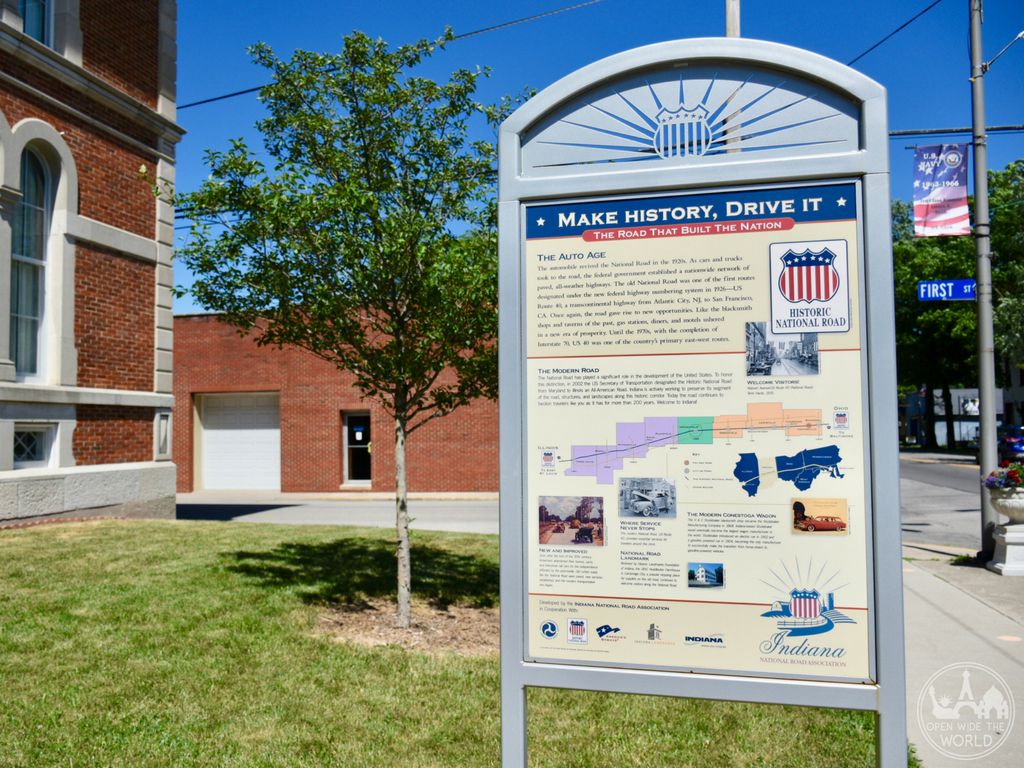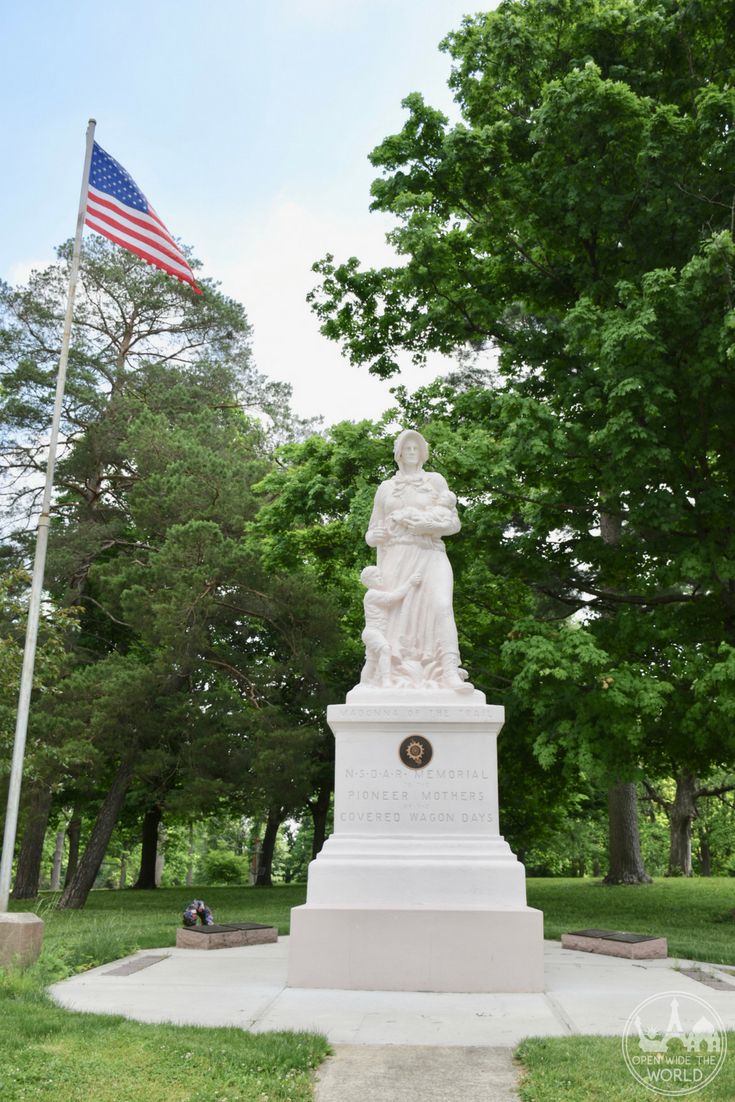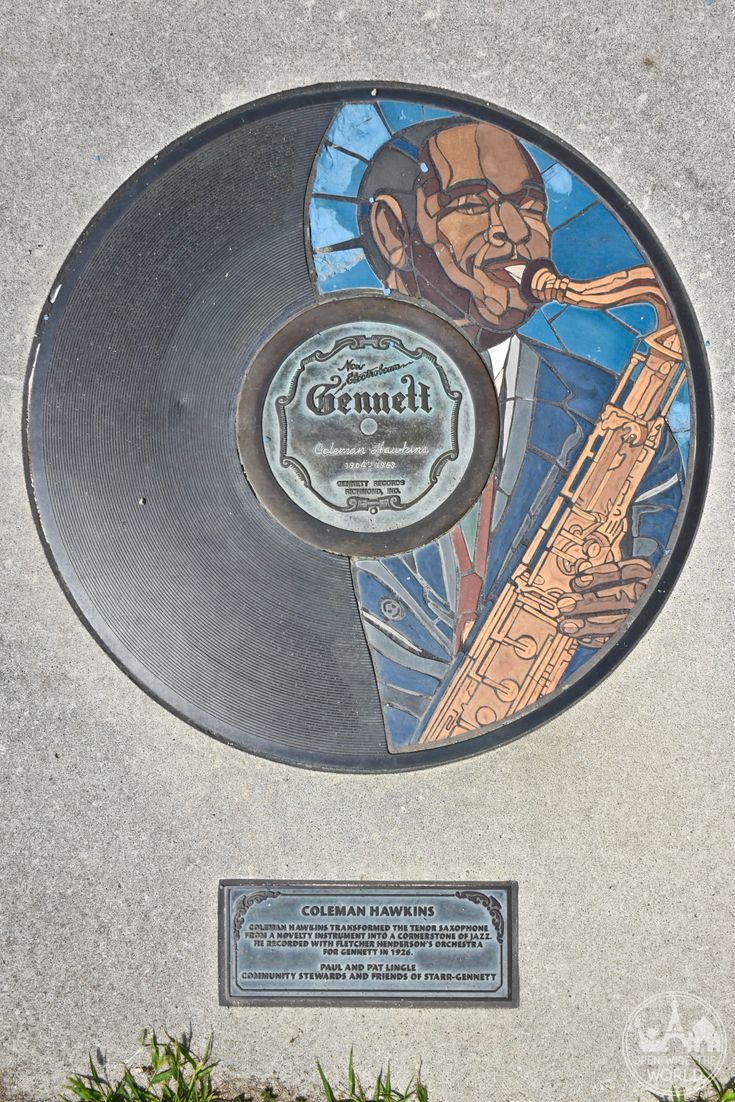Richmond, Indiana: a History Lover's Destination
Small Midwestern cities so often get overlooked by would-be visitors; visitors who seek out the big, the showy, the easy and obvious destinations. But history loving travelers know the best trips aren't always about what's conspicuous. We understand that if you know where to look and how to dig, you can find fascinating stories in lesser known destinations; places whose stories you will love and who will call you back.
Richmond, Indiana is one of those places. Richmond's story is intertwined with the story of our nation, and they've found so many amazing ways to share it.
∙ our sincere gratitude to Visit Richmond for hosting our stay in amazing, historic Richmond ∙
1827: The National Road Arrives
The National Road is the perfect place to begin a history visit to Richmond; not just because the area's Welcome Center is right along The National Road, but because it would be nearly impossible to find something more historically American than The National Road. Conceived by George Washington, authorized by Thomas Jefferson and traveled by Abraham Lincoln, The National Road was our new nation's first federally funded interstate highway.
Although Quakers had already been settling the Richmond area since 1805 (many coming up from North Carolina, desiring to leave that state's slave culture), it was the arrival of The National Road through Richmond in 1827 that was the catalyst for the area's prosperity.
Richmond became a "pike town" along The National Road. Pike towns, spaced about a day's travel apart, provided services for travelers heading westward. Over time, pike towns like Richmond evolved into prosperous communities with diverse local economies, beyond merely an economy based on caring for travelers.
The National Road saw several heydays. During the 1830s-50s, it took settlers west by horse, wagon, and even on foot. For a time, railroads and canals overtook The National Road in its role as primary route. But then the affordability of the automobile in the 1920s brought a new era of glory to The National Road.
When it was renamed U.S. Route 40 by the Federal Highway Act in 1921, The National Road became one of the first transcontinental roadways. The National Road now took travelers from Atlantic City, New Jersey to San Francisco, California.
Development of the interstate freeway system in the 1960s and 70s saw U.S. Route 40 devolve to the functional status of a local road. But nostalgia seekers and history lovers will see in it to this day its role in the shaping of a region and of a nation.
Our visit
Along the National Road, we realized that the average person driving the road that day was probably just thinking about their 7-minute commute to wherever they were going. But we used our time on the road to embrace the daydreams of those who had been there before us, the life dreams they were chasing, the hardships they were overcoming, the hopes and trials the road has represented over the years. We couldn't help but be struck by how much of our nation's story, and even our personal stories, can be told or paralleled in a single road.
A series of 12 Madonna of the Trail statues can be found along the route from Maryland to California; this one in Richmond.
Visiting The National Road Interpretive Panels
Interpretive panels in Richmond (from east to west):
Old National Road Welcome Center, 5701 National Road. E., Richmond
Glen Miller Park, corner of E. Main & N. 22nd Streets, Richmond
NOTE: Don't miss the Madonna of the Trail statue near the Glen Miller Park panel... and the star bricks near the side of the statue!
Interpretive panels near Richmond:
Centerville Library, 126 E. Main St., Centerville
Huddleston Farmhouse Inn Museum, 838 National Rd., Cambridge City
Admission: FREE - just drive up, park the car and step out to read and photograph the interpretive panels.
1830's-1850's: The Work of Abolitionists
Just off The National Road and slightly north of Richmond, the small town of Fountain City (formerly Newport) was home to "Grand Central Station of the Underground Railroad;" three escape routes heading from slave states northward converged in Newport.
During the antebellum years, many area Quakers -who themselves had moved north to Indiana from slave states-, defied the law and risked their own liberty and security to assist thousands of enslaved men, women and children find freedom in the northern states and Canada.
Note: The Fugitive Slave Acts of 1793 and 1850 made it a federal crime, punishable by heavy fines and imprisonment, to assist slaves in escaping to freedom.
A few feet wide, a few feet tall, and the length of a bedroom, this hiding space's opening could quickly and easily be hidden behind a piece of furniture.
More than 2000 of those freedom seekers passed through the home of Quakers Levi and Catharine Coffin. The Coffin house (shown above), built in 1839, was designed specifically for the work of assisting, hiding, resting, and safely transporting freedom seekers heading northward. Today, their home is one of the best remaining Underground Railroad depots in the country.
Visitors to the Coffin House will first get acquainted with the Coffins in a state-of-the-art interpretive center. Then, while touring the Coffin's home, visitors will hear stories of freedom seekers who passed through the house, as well as explore the various modifications the Coffins devised to continue their work. A visitor favorite is a secret cupboard built into a wall.
Our visit
This site was the cornerstone of our visit to the Richmond area. Powerful and moving. Touring rooms that sheltered and cared for some 2000 freedom seekers was almost indescribable, all the moreso for Mag who had just studied slavery and the Underground Railroad in school this year.
→ Read more about the Coffin House, the tour, and our experience here. ←
Visiting the Levi and Catharine Coffin House State Historic Site
Location: 201 U.S. 27 North, Fountain City, IN
Hours:
Tuesday - Sunday, 10:00am - 5:00pm
Closed Mondays, except Monday holidays: Memorial Day, Labor Day, Columbus Day, Veterans Day
Open Martin Luther King, Jr. Day and Presidents Day
Closed on Easter, Thanksgiving, Christmas
Note: To visit in April or May, Tuesday through Friday, call ahead. School groups visits may limit availability of walk-in tours.
Admission:
Adults: $10
Seniors 60+: $8
Children 3-17: $5
Children under 3: FREE
1870-Present: Impactful Richmond Art
Shortly after the Civil War, in 1870, a group of primarily self-taught, plein-air Impressionist painters in Wayne County formed Indiana's first artist colony, the Richmond Group.
The Richmond Group flourished for several decades, enough that in 1898, the Art Association of Richmond was established “to arrange for an annual exhibit of works of art produced by home people.” Within a few years, renowned artists from Chicago, New York and all around the U.S. were sending works to Richmond's Annual Exhibition.
The annual AAR exhibit, since its inception, has always been held in local school buildings. In similar style, today's Richmond Art Museum (the new name for the Art Association of Richmond) is housed within Richmond High School, a WPA-built, colonial revival style building listed on the National Register of Historic Places.
The Richmond Art Museum is the second oldest museum in Indiana. RAM recently celebrated its 120th anniversary with a $1.7 million renovation, and the welcoming home from Venice their beloved "Self Portrait of William Merritt Chase" (pictured above).
Our Visit
We pulled into town just as the museum was kicking off its 120th anniversary celebration and renovation ribbon cutting. So we got the full museum experience, plus speeches, hors d'oeuvres and harp music!
All ceremony aside, we were intrigued by an era and region of American art that was new to us. We also appreciated the locals' pride in their town and its focus on art for the average person; we had a good chat on art appreciation and art history with museum director Sean Dingwerth; and we loved being surrounded by period architecture.
Visiting the Richmond Art Museum
Location: 915 E. Main Street, Richmond
Hours:
Tuesday - Friday, 11:00am - 5:30pm
Saturday 10:00am - 4:00pm
Closed Sunday, Monday and national holidays
Admission: FREE!
1908-1927: The Ford Model T Rules the Road
Around the same time that American artists were first discovering the Richmond art scene -about the turn of the last century-, the automobile was about to make intercity travel a more routine event.
At that point, with several rail lines and The National Road passing through, Richmond was considered a mecca of transportation. And so, despite the fact that the Ford Model T was never actually manufactured in Richmond, the city is an understandable choice to be home to the museum for "the car that put the world on wheels."
Richmond's Model T Museum houses a growing and evolving collection of operable (yes, they all drive!) Model Ts. Among the highlights are a 1909 touring (one of the very first Ts), a 1922 T customized as a snowmobile to deliver mail in Minnesota, and a 1927 coupe (one of the last Ts), as well as a 1931 Pietenpol airplane with a Model T Engine.
Of course, the cars are the stars of the show here... but they're not outshone by the staff! Docent Justin is like a tour guide and stand-up comedian all in one. And if the weather's right, he might just take you out for a drive in one of the T's. And even let you blow its iconic "aaooogah!" klaxon.
Our Visit
When Docent Justin greeted us on our arrival and mentioned that we might expect to spend 90 minutes in the museum, I glanced around and thought to myself, "maybe more like 30." The next thing I knew, almost two hours has passed.
The cars are beauties, their histories fascinating, and Justin's retelling entertaining. Our ride in a Model T woody was just the icing on the cake!
I had an average interest in automobile history before this visit; I am a huge Model T fan now!
Visiting the Ford Model T Museum
Location: 309 N. 8th Street, Richmond
Hours:
Tuesday - Sunday, 10:00am - 5:00pm
Closed Monday
NOTE: The Museum closes at 4:00pm during January, February, and March.
Admission:
Adults: $3
Children 12 & under: FREE
Free for Model T Ford Club members
1916-1934: Gennett records Breaks Music Barriers
While roads and autos were connecting the nation in many ways, racial and regional separation was a reality on many levels, the music industry included. Not so in Richmond's music scene.
Beginning as piano factory in 1872 (then named Starr), Richmond's Gennett Records signed talent that was overlooked (or worse) by established labels, typically due to their "ethnic" or regional sounds.
Gennett Records is well-known for its groundbreaking recordings of numerous jazz pioneers like Louis Armstrong, Jelly Roll Morton and Duke Ellington.
At a time when "the big three" record labels (Columbia, Edison, and Victor) only recorded expensive East Coast talent in limited, mainstream genres, Gennett found their backdoor into the recording industry by working with affordable local talent who played otherwise unaccepted regional styles.
These styles, including jazz, blues and Delta blues, "old time music" (a precursor to country), and gospel were, at the time, little known outside their regions. But the Gennett-recorded styles would eventually engender nearly all the popular music styles heard today.
Music history fans can take a stroll down a literal memory lane at the Gennett Records Walk of Fame. This sidewalk near the sole remaining Starr-Gennett building features inlays designed as '78 rpm records, each commemorating an artist or group who recorded with Gennett, as well as a small plaque summarizing their contribution to the company and the music world.
"Coleman Hawkins transformed the tenor saxophone from a novelty instrument into a cornerstone of jazz. He recorded … for Gennett in 1926."
Our Visit
Homer is a musician, Mag appreciates jazz, and we all love the outdoors. So a stroll along the Hall of Fame sidewalk was a pleasant break in a busy trip.
We thought the uniqueness of the record-shaped mosaic inlays was a fun twist on the standard walk of fame concept, and very photogenic.
It was so intriguing learning about the musicians that we loaded a Gennett artists playlist to listen to for the rest of the day.
Visiting Gennett Records Walk of Fame
Location: S. 1st Street, Richmond
Admission: Free
Want all this history in one stop?
Then check out the Wayne County Historical Museum!
Named one of the outstanding local museums in the country, the Wayne County Historical Museum goes beyond what is expected of a typical rural county museum; in part, because its early benefactor, Julia Meek Gaar, collected treasures from around the world (including one of only two mummies exhibited in the State of Indiana), but also in large part because Richmond and Wayne County have ties to so many surprising historic events, movements and inventions.
A stroll through the eight buildings on the small museum campus reveals Wayne County's many historic ties: early aviation, the "horseless carriage" revolution, pioneering music movements, the invention of cruise control and lawn mowers, and more.
A fair bit of placard-reading is necessary to make the most out of this museum visit. Fortunately, families with children will be happy to know there are many interactive elements sprinkled throughout the museum to engage children (e.g., a mummy scavenger hunt, "learn-touch-do" treasure trunks, and more).
Our visit
Our first step into this museum gave me one of those, "uh-oh... how's this going to be?" feelings. I thought, "The furnishings are old; will this be quaint or outdated? The exhibits are packed in; is there a lot to see, or is it just disorganized and uncared for?"
Within moments, it was clear: this is one of those magical places like you see in a movie. The kind of place with a mysterious, eccentric owner behind a counter; where the protagonist finds the secret to something long sought within the amber glow of the eclectic disarray. A place that feels like you've stepped out of everyday life and into mystical storyline. Except it's a true story; the story of Wayne County.
Visiting the Wayne County Historical Museum
Location: 1150 N. A Street, Richmond
Hours:
Monday - Friday, 9:00am - 4:00pm
Saturday, 1:00pm - 4:00pm
Closed Sunday
Admission:
Adults: $7
Students (age 6-17): $4
Children 5 & under: FREE
Has all this history got you hungry?
Richmond's Historic Depot District is a vibrant neighborhood where murals abound and businesses are housed in repurposed 19th Century buildings and warehouses - the perfect place for history loving travelers to grab a bite!
Ice Cream
Ullery's Home-made Ice Cream, 168 Fort Wayne Ave., Richmond
Ullery's Homemade Ice Cream has been making real hand-crafted homemade ice cream since 1993.
We recommend the Dave Snow, an oversized affogato invented by Richmond's mayor.
Coffee
Roscoe's Coffee Bar & Tap Room, 185 Fort Wayne Ave., Richmond
Roscoe's is a blending of a high end coffee bar, a wine and craft beer tap room, as well as a unique sandwich shop.
We like Roscoe's nitro cold brew coffee and their passionfruit smoothie.
Tea
Two Little Sisters Books & More, 193 Fort Wayne Ave., Richmond
A used bookshop with a cupboard under the stairs - every Harry Potter fan's dream reading nook.
And they serve tea, besides!
Beer
New Boswell Brewery, 923 N. E St., Richomnd
New Boswell Brewery & Tap Room was Richmond's first microbrewery after Prohibition. Kids can enjoy craft root beer while adults sample house brews.
A Drink
Cordial Cork, 911 N. E St., Richmond
Offering wine, small plates, and desserts
Try the Richmond music history inspired wine slushies!
A Lite Bite
Little Sheba's Restaurant, 175 Fort Wayne Ave., Richmond
Little Sheba's 40+ specialty sandwiches have got names with attitude... and all come served with a large side of personality!
Dinner
Kitchen at the Loft, 416 N. 10th St., Richmond
Farm to table restaurant offering handcrafted food, handcrafted cocktails and handcrafted beer.
We enjoyed the meatloaf with black pepper gravy and dessert pastries from nearby Ghyslain Chocolatier.
More Dinner
Firehouse BBQ & Blues, 400 N. 8th St., Richmond
Serving hickory smoked BBQ in Richmond's oldest firehouse.
We loved the pulled pork and sweet potato casserole. And we already have our eye on the BBQ nachos for next time!
Nearby
Galo's Italian Grill, 107 Garwood Rd., Richmond
Not in the Historic Depot District, but worth a mention for its proximity to hotels, plus its fabulous food.
We recommend the oosso buco, a Milanese veal shank.
Do you love history travel, too?
What would be your first stop in Richmond?
Tell us about it!











